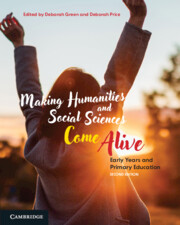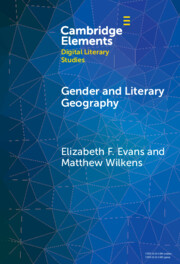Refine search
Actions for selected content:
191 results
Dos lógicas espaciales en confrontación: Entre la planificación estatal y la territorialidad comunitaria en el Caribe colombiano
-
- Journal:
- Latin American Research Review ,
- Published online by Cambridge University Press:
- 12 December 2025, pp. 1-17
-
- Article
-
- You have access
- Open access
- HTML
- Export citation
An Expert in the Field: Discovering the Traditional Borders of Late-Qing Geo-knowledge in the Himalayas
-
- Journal:
- Journal of Chinese History / Volume 9 / Issue 2 / July 2025
- Published online by Cambridge University Press:
- 01 December 2025, pp. 379-403
-
- Article
-
- You have access
- Open access
- HTML
- Export citation

Nationalism and the Transformation of the State
- Border Change and Political Violence in the Modern World
-
- Published online:
- 27 November 2025
- Print publication:
- 23 October 2025
-
- Book
-
- You have access
- Open access
- Export citation
1 - Nationalism and the State in the Literature*
- from Part I - Setting the Analytical Stage
-
- Book:
- Nationalism and the Transformation of the State
- Published online:
- 27 November 2025
- Print publication:
- 23 October 2025, pp 17-30
-
- Chapter
-
- You have access
- Open access
- Export citation
1 - The Making of Europe
-
- Book:
- An Economic History of Europe
- Published online:
- 02 October 2025
- Print publication:
- 02 October 2025, pp 15-38
-
- Chapter
- Export citation
Chapter 38 - The Atlantic and the Americas
- from Asia and the Americas
-
-
- Book:
- The Cambridge Guide to Global Medieval Travel Writing
- Published online:
- 03 October 2025
- Print publication:
- 02 October 2025, pp 672-685
-
- Chapter
- Export citation

Death Rituals
- The Rūs and 'Vikings' in Arabic and Persian
-
- Published online:
- 13 September 2025
- Print publication:
- 09 October 2025
-
- Element
- Export citation
Chapter 4 - The Geographies of British Postmodern Fiction
-
-
- Book:
- The Cambridge Companion to British Postmodern Fiction
- Published online:
- 07 August 2025
- Print publication:
- 21 August 2025, pp 66-81
-
- Chapter
- Export citation
Chapter 1 - Forming the Kingdom of Alania, c.800–880
-
- Book:
- The North Caucasian Kingdom of Alania, 850–1240
- Published online:
- 17 December 2025
- Print publication:
- 21 August 2025, pp 41-88
-
- Chapter
- Export citation
Chapter 8 - Making Geography come alive by teaching geographical thinking
- from Part II - HASS concepts and sub-strands
-
-
- Book:
- Making Humanities and Social Sciences Come Alive
- Published online:
- 02 August 2025
- Print publication:
- 14 August 2025, pp 134-154
-
- Chapter
- Export citation

Making Humanities and Social Sciences Come Alive
- Early Years and Primary Education
-
- Published online:
- 02 August 2025
- Print publication:
- 14 August 2025
-
- Textbook
- Export citation
1 - The Balkan Peninsula and Its Languages
-
- Book:
- The Balkan Languages
- Published online:
- 31 May 2025
- Print publication:
- 26 June 2025, pp 11-64
-
- Chapter
-
- You have access
- Open access
- HTML
- Export citation
8 - Mapping the Holocaust
-
-
- Book:
- The Cambridge History of the Holocaust
- Published online:
- 16 May 2025
- Print publication:
- 12 June 2025, pp 152-173
-
- Chapter
- Export citation

Gender and Literary Geography
-
- Published online:
- 21 April 2025
- Print publication:
- 22 May 2025
-
- Element
- Export citation
23 - Papal Warfare in the Fourteenth Century
- from Part V - Papal States
-
-
- Book:
- The Cambridge History of the Papacy
- Published online:
- 28 February 2025
- Print publication:
- 20 March 2025, pp 612-631
-
- Chapter
- Export citation
“The Backside of Japan,” Development, and Imperialism in Northeast Asia
-
- Journal:
- Asia-Pacific Journal / Volume 19 / Issue 6 / March 2021
- Published online by Cambridge University Press:
- 14 March 2025, e2
-
- Article
-
- You have access
- Open access
- Export citation
1 - Global Europe
-
-
- Book:
- Globalizing Europe
- Published online:
- 06 March 2025
- Print publication:
- 13 March 2025, pp 1-26
-
- Chapter
- Export citation
6 - Tourists as Shamanic Spirits
-
- Book:
- The Shamanism of Eco-Tourism
- Published online:
- 30 January 2025
- Print publication:
- 06 February 2025, pp 125-145
-
- Chapter
- Export citation
Chapter One - Prolegomenon
-
- Book:
- The Peopling of the Caucasus
- Published online:
- 21 January 2025
- Print publication:
- 23 January 2025, pp 1-8
-
- Chapter
- Export citation
1 - Kurdistan
-
- Book:
- The Political Ecology of Violence
- Published online:
- 22 November 2024
- Print publication:
- 05 December 2024, pp 36-90
-
- Chapter
- Export citation
